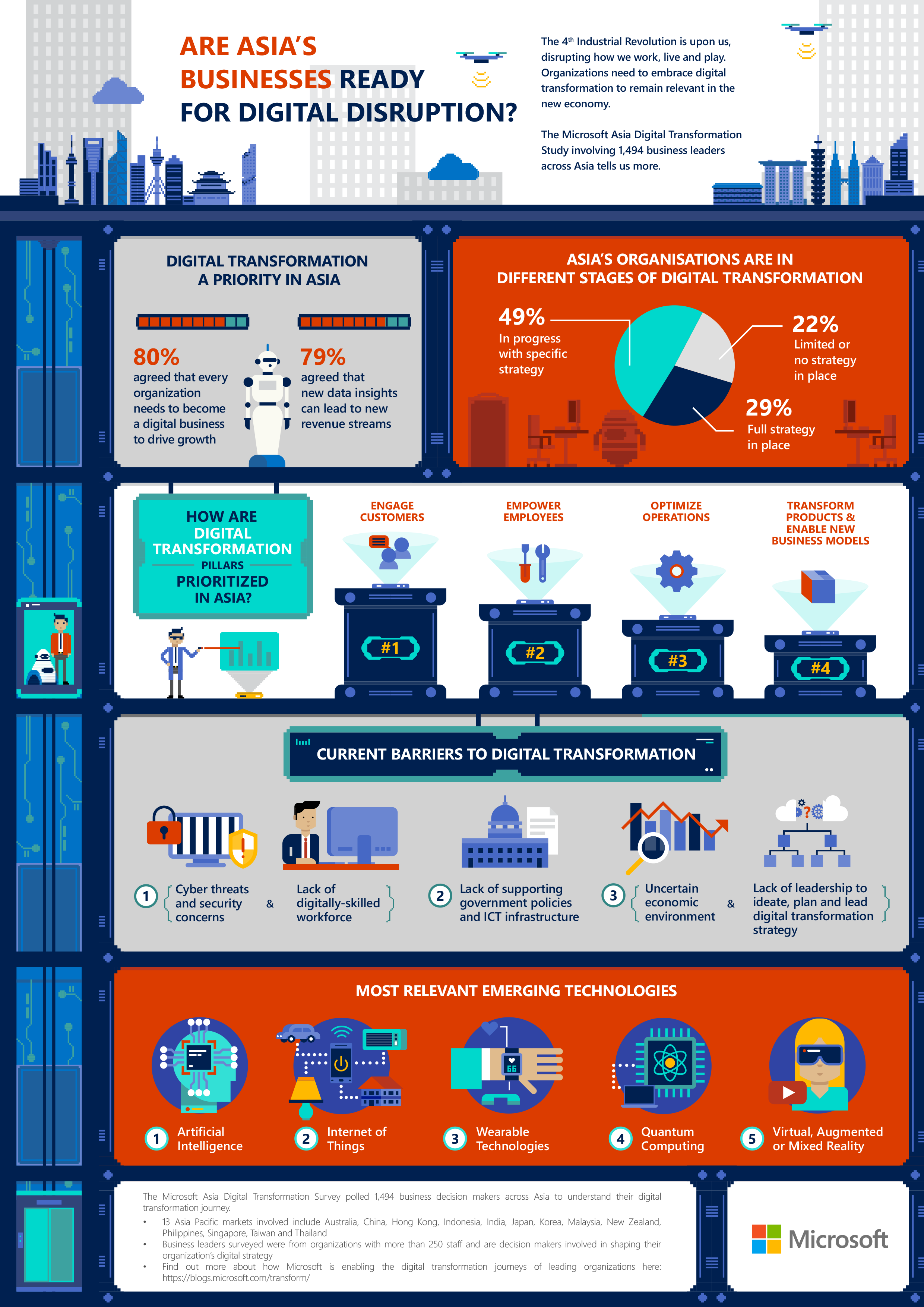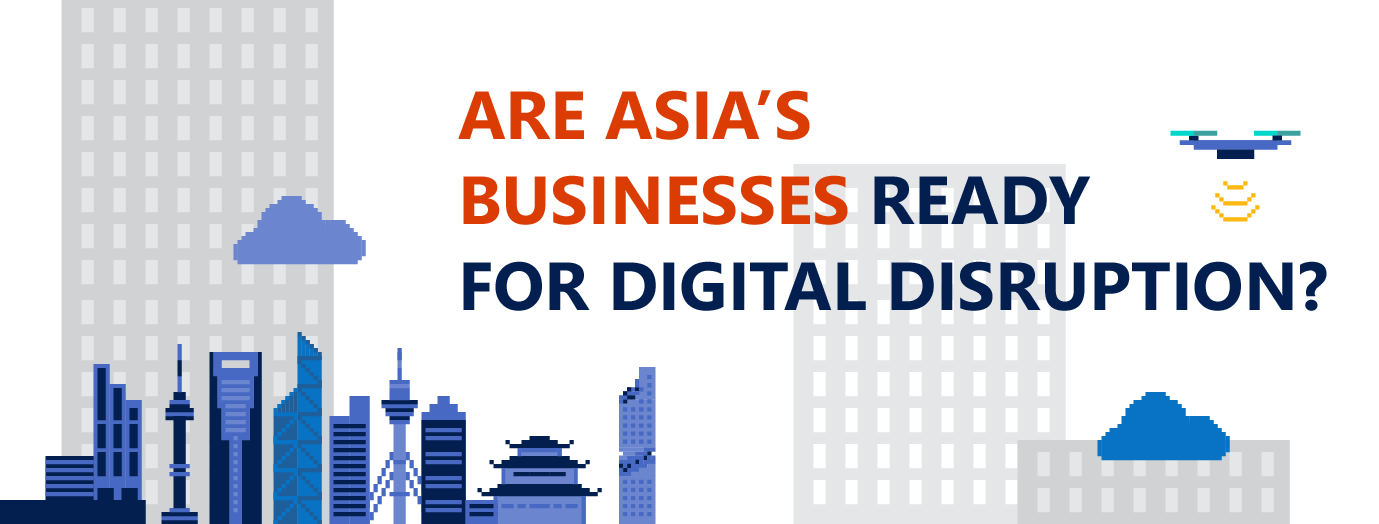13-market Microsoft Asia Digital Transformation Study shows that business leaders are just starting to embrace disruptions as region ushers in the 4th Industrial Revolution.
Asia Pacific, 20 February 2017 – Business leaders in Asia Pacific are showing urgency in embracing the 4th Industrial Revolution, where 80% of them believe that they need to transform to a digital business to enable future growth and yet only 29% said that they have a full digital strategy in place today. These are some of the key findings of the Microsoft Asia Digital Transformation Study[1] to understand how business leaders are embracing the digital era.
Technology advancements have ushered in the 4th Industrial Revolution, where cutting-edge technologies such as Internet of Things (IoT), artificial intelligence (AI), advanced data analytics, and mixed reality are powered by cloud computing to create limitless possibilities in transforming the way people work, live and play. This revolution, together with rapid urbanization, emergence of the millennial workforce and a fragile global economic climate, is ushering societal and economic changes at an unprecedented pace.
The Microsoft Asia Digital Transformation Study surveyed 1,494 business leaders from Asia Pacific working in organizations with more than 250 employees from 13 Asia Pacific markets: Australia, China, Hong Kong, Indonesia, India, Japan, Korea, Malaysia, New Zealand, Philippines, Singapore, Taiwan and Thailand. All respondents were pre-qualified as being involved in shaping their organizations’ digital strategy.
Even as majority of business leaders are aware of the urgent need to transform digitally to address the changing business climate, the study found that the transformation journey for most organisations in Asia is still at its infancy. In fact, only 29% of business leaders have a full digital transformation strategy and less than half (49%) are in progress with specific digital transformation initiatives for selectedf parts of their business. 22% still have very limited or no strategy in place.
Ralph Haupter, President, Microsoft Asia said: “The Microsoft Asia Digital Transformation Study has shown that business leaders have started to act on the need for digital transformation to address the challenges and opportunities of the 4th Industrial Revolution in the region. Lessons from past industrial revolutions have taught us that organisations that do not evolve fast enough will be less competitive or even obsolete as they face disruptions in every industry. We urge organisations of all sizes to digitally transform themselves amidst changing demands externally and internally, to stay relevant. At Microsoft, we believe this involves transformation in four key pillars – empowering employees, engaging customers, optimizing operations and transform with new products, services or business models, and data and the cloud are key enablers of these.”
Clear Priorities for Digital Transformation but True Transformation Lacking
Microsoft has defined what it means to transform in four key pillars:
- Engage customers: Consumers are savvier than ever before, with access to data ensuring they are often educated on a product or service before engaging. To stand out, organisations will need to deliver a new wave of deeply contextual and personalized experiences, while balancing security and user trust.
- Empower employees: The nature of how we work—and the workplace itself—has undergone a dramatic evolution. Organisations can empower their people and help them do their jobs better with the power of mobility, which allows employees to collaborate from anywhere, on any device, and access apps and data they need, while mitigating security risks.
- Optimize operations: Technology disrupters such as IoT are accelerating the potential for businesses to optimize their operations. This can be done by gathering data across a wide, dispersed set of endpoints, drawing insights through advanced analytics, and then applying those learnings to introduce improvements on a continuous basis. Organisations in manufacturing, retail, and even healthcare can shift from merely reacting to events to respond in real time, or even pre-emptively anticipating and solving customer issues.
- Transform products & business models: The opportunity to embed software and technology directly into products and services is evolving how organisations deliver value, enabling new business models, and disrupting established markets.
The Study shows how business leaders in Asia are prioritizing their digital transformation strategies:

Said Haupter: “It was interesting to learn that 79% of business leaders felt that new data insights would lead to new revenue streams. And yet, it is concerning to see that while there is widespread acknowledgement on the need to transform, they are doing so incrementally. With constant pressure from newer, agile and tech savvy players disrupting across industries in Asia, the transformation of products and new revenue models provides the greatest opportunity for organisations to truly lead rather than be disrupted. Leaders need to rethink business models, find new data insights which lead to new revenue streams. And they need to do this by embracing a different way of bringing together people, data, and processes. which create value in a new digital business.”
Emerging Technologies in Demand

Cloud computing and the decreasing cost of devices have made it more affordable for companies of any sizes to transform digitally, according to 81% of business leaders surveyed. Majority of business leaders (78%) regarded cloud computing as essential in their digital transformation strategy.
In the next 12 to 18 months, business leaders in Asia Pacific are interested to explore a range of emerging technologies to accelerate and achieve digital transformation. The top five technologies identified by business leaders as being relevant to them are:
- Artificial intelligence: Intelligent machines or software that are able to learn and perform tasks independently. Examples include robots, chatbots and self-driving cars;
- Internet of Things (IoT): Network of sensors embedded into devices that can collect data or be remotely controlled. Examples include smart buildings, cars and home devices;
- Wearable technologies: Advanced computing and electronic technologies that are embedded into clothing, devices or bodies. Examples include smart watches and fitness trackers;
- Quantum computing: Next-generation computers using different computation systems to solve data equations much faster than traditional computers
- Virtual/ augmented/ mixed reality: Technologies enabling the merging of real and virtual worlds into new and immersive experiences. Examples include Microsoft HoloLens, Oculus Rift, and 3D video gaming.
Haupter added: “Emerging technologies, specifically, cloud, analytics and new capabilities like AI and IoT will give organisations new capability to transform. But real transformation only happens when they bring their people along with them. Equipping employees with the right tools to enable them to be part of solution to be more responsive, data driven and customer centric are also key.”
Barriers to Digital Transformation in Asia Pacific
While there is no doubt that digital transformation will bring significant benefits for both businesses and employees, the path to digital transformation has been slow, given that only 29% have a full digital strategy in place.
According to business leaders in the study, the top barriers to digital transformation are, in order of priority:
Increasing security threats in today’s digital economies is real and cannot be ignored. There is a continued perception among business leaders that the cloud is less secure. However, they may be less privy to the advances being made in the cloud on security and privacy and need more exposure on how, with the current threat environment, it will be safer being in the cloud than relying on tradition forms of IT. In fact, a recent Microsoft Asia Pacific survey of 1,200 IT leaders [2] conducted in September 2016 found that 87% believe that in the longer term, the cloud will be safer.
“People don’t use technology that they don’t trust. This is a golden rule that applies to organisations and individuals alike as we live in a mobile-first and cloud-first world. Ensuring security, privacy, and compliance are key to enabling businesses to carry out digital transformation with confidence. With the rise of mobile workers introducing new devices, apps, and data into organisations today, protecting sensitive company data requires a new and integrated approach, all of which we have invested in significantly,” said Haupter.
Microsoft’s mission is to empower every person and every organisation on the planet to achieve more—building technology so that others can innovate, build their own technology, and create solutions that make things happen. Microsoft is uniquely able to enable businesses of all sizes to get from where it is today, to where it needs to be as digital business through its flexible technology solutions, integrated offerings and our investment in being the most trustworthy with investments in security, privacy and control, compliance, and transparency.

To find out more about how Microsoft is enabling digital transformation for organisations, visit blogs.microsoft.com/transform/.
[1] The Microsoft Asia Digital Transformation Study was conducted between October to November 2016 involving 1,494 business leaders in 13 Asia Pacific markets. The 13 markets include Australia, China, Hong Kong, Indonesia, India, Japan, Korea, Malaysia, New Zealand, the Philippines, Singapore, Taiwan and Thailand. All respondents were pre-qualified as being involved in shaping their organisations’ digital strategy, and are working in firms with more than 250 employees.
[2] Microsoft Asia Pacific survey of 1,200 IT leaders across 12 markets to understand how they are evolving their IT infrastructure strategies to meet the needs of a digital business. Read more here: https://news.microsoft.com/apac/2016/11/24/microsoft-survey-it-leaders-in-asia-are-prioritizing-hybrid-cloud-to-transform-it/






